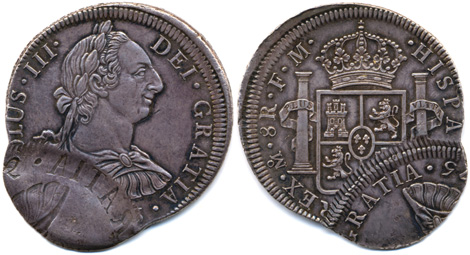 For fifty years or so before the first U.S. dollars were coined (by the U.S. Mint), the most widely accepted dollar-size coin circulating in the American Colonies was the Spanish-American “pillar dollar”, or “piece of eight”. It was valued at 8 reales. And even after the mint began producing dollars in 1794, Spanish-American coinage continued to be legal tender in the United States for over sixty years... that is, until 1857. Therefore an eight reale piece like this one, struck in Mexico in 1775, would have made the rounds in the American Colonies, and later would have circulated freely, equivalent to one U.S. Dollar, in the United States of America.
For fifty years or so before the first U.S. dollars were coined (by the U.S. Mint), the most widely accepted dollar-size coin circulating in the American Colonies was the Spanish-American “pillar dollar”, or “piece of eight”. It was valued at 8 reales. And even after the mint began producing dollars in 1794, Spanish-American coinage continued to be legal tender in the United States for over sixty years... that is, until 1857. Therefore an eight reale piece like this one, struck in Mexico in 1775, would have made the rounds in the American Colonies, and later would have circulated freely, equivalent to one U.S. Dollar, in the United States of America.
 But what has happened to this particular piece? First, it was struck slightly off-center to about 7:30 o’clock. Then it flipped over and was struck a second time, about 75% off-center to 7:00. However, during the second strike it was sandwiched between the obverse die on one side, and the obverse of an already struck coin on the other. This produced a partial brockage (indent of the the obverse of an already struck coin) on the obverse of our coin, and a clear flip-over, double-strike on the reverse. The 1775 date is indicated by the “75” that shows from the second strike on the reverse.
But what has happened to this particular piece? First, it was struck slightly off-center to about 7:30 o’clock. Then it flipped over and was struck a second time, about 75% off-center to 7:00. However, during the second strike it was sandwiched between the obverse die on one side, and the obverse of an already struck coin on the other. This produced a partial brockage (indent of the the obverse of an already struck coin) on the obverse of our coin, and a clear flip-over, double-strike on the reverse. The 1775 date is indicated by the “75” that shows from the second strike on the reverse.
 These four error features are then as follows: off-center, flip-over, double-strike and partial brockage. Come to think of it, maybe this particular coin wouldn’t have been so readily accepted in the American Colonies.
These four error features are then as follows: off-center, flip-over, double-strike and partial brockage. Come to think of it, maybe this particular coin wouldn’t have been so readily accepted in the American Colonies.


